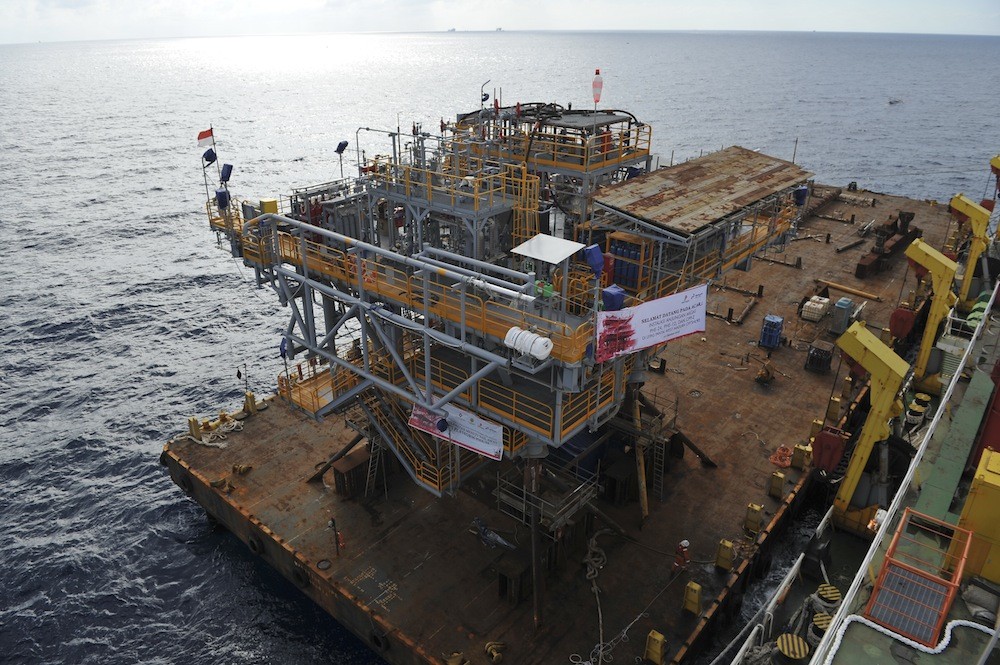Popular Reads
Top Results
Can't find what you're looking for?
View all search resultsPopular Reads
Top Results
Can't find what you're looking for?
View all search resultsRestricted space and volatile prices trouble Pertamina
Change text size
Gift Premium Articles
to Anyone
L
imited working areas and unstable oil prices are among the challenges that state energy holding company Pertamina has to face this year to maintain its oil and gas production.
The hurdles were outlined by one of Pertamina’s upstream subsidiaries, PT Pertamina EP (PEP), on Tuesday after the company said its performance throughout 2018 showed a “positive result”.
“Our working areas are limited; we even have had an idea to swap some of our areas and to give back about 22,000 square kilometers to the government,” PEP president director Nanang Abdul Manaf said in a recent press briefing.
PEP currently manages five assets that consist of at least 21 oil and gas fields located across Indonesia, such as on Sumatra and Java and in Papua. The total area of the assets was about 113,629 square kilometers.
Nanang said the firm has proposed the swaps to the Upstream Oil and Gas Regulatory Task Force (SKKMigas) and to Deputy Energy and Mineral Resources Minister Arcandra Tahar.
“Now we are only awaiting for the minister to approve our plan or not," he said. "We believe that to find a new giant discovery, we need a new playground."
PEP also pointed out that the volatile global oil prices would create a big risk for the firm’s performance this year. The average Indonesian Crude Price (ICP) was US$54.81 per barrel in December 2018.
“I only wished that it would not go down below $50 per barrel and it would be stable. Those are the only two things that the business players want,” he said.
The Wood Mackenzie global energy think tank predicts that the average price for Brent would reach $65 per barrel in 2019 and $68 per barrel in 2020.
Furthermore, PEP exploration director A. Alfian Husein said that higher oil prices would help the company maintain its gross annual profits at about $750 million.
“We aimed to book $755 million in gross profits this year, $2 million higher than last year’s achievement. It would be achieved this year if the oil prices are stable and our efficiency measures succeed,” he said.
As of December 2018, the average oil and gas production of PEP was 255,000 barrels of oil per day (boepd), 101 percent of its target of 253,000 boepd thanks to its average gas output last year, which was 103 percent of its target.
However, its average oil production was 4 percent less than its target of 83,000 bopd as the firm only booked 79,690 bopd, which put it in third place among the country’s top oil producers after two US-based energy giants, Chevron and ExxonMobil.
Despite failing to meet its oil production target last year, Nanang of PEP was optimistic about the higher target of 85,000 bopd set this year because of the provisions for well work-overs, servicing and interventions to maintain or even increase production rates.
“We aimed to drill 102 wells throughout this year, eight of which are exploration wells. That is 10 more wells than last year. Therefore, we are still optimistic this year,” he said.
Yet, PEP said it hopes that government could provide incentives for well works to achieve their aim of getting an even better production rate, which went from 2.5 percent in 2017 to 7 percent in 2018.
“Chemical injection for our enhanced oil recovery [EOR] project is expensive, but it is effective to increase our production by about 60 percent of our production,” said PEP development director John H. Simamora. "There should be an incentive from government for those who conducted EOR."
He said that currently the firm only performed water-based injections in their EOR program, which could increase the production in one unit by up to 40 percent.
Meanwhile, PEP has set a lower gas production target this year of 815 million standard cubic feet per day (mmscfd), 11.02 percent down from last year's target at 916 mmscfd.
“The lower target is due to a natural cause in the Pendopo Field [of South Sumatra] that made us to lower the usual production rate in the unit by almost half,” PEP production and operational director Chalid Said Salim said.
Therefore, the total average PEP oil and gas production target for 2019 is about 252,000 boepd, 0.3 percent down from last year’s target of 253,000 boepd.
Pertamina’s upstream directorate also vowed to increase production this year through the EOR program and to double their well drillings from last year’s 346, 27 of which were exploration wells.
“As a state company that operates assets belonging to the country, we will continue to strengthen our production baseline to ensure that the recovery factor is economical and effective.” Pertamina upstream director Dharmawan H Samsu said recently.
Pertamina has allocated $2.5 billion for upstream investment this year, including for geothermal energy. The allocation was 19.3 percent lower than 2018’s allocation of $3.1 billion.
Meanwhile, the firm also slashed its 2019 oil and gas upstream target from 933,000 boepd in 2018 to 922,000 boepd, a cut of 1.17 percent.
Last year, Pertamina failed to reach its target for oil and gas production after closing 2018 with an average output of 921,000 boepd, 98.7 percent of its target of 933,000 boepd.










